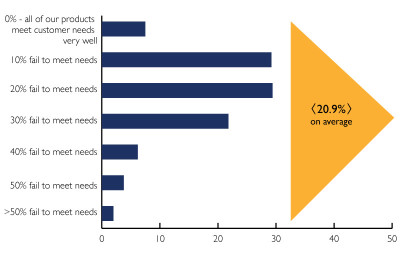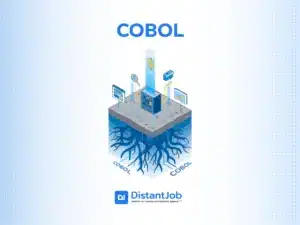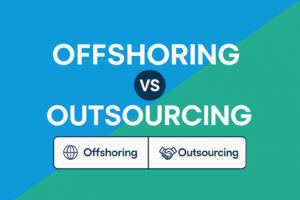When it comes to ensuring your products are successful, it’s not just important to hire top performing developers, you actually also need to hire the right Product Development Managers. So much so that recent information shows that 56% of companies state that their PDMs could actually be better at their jobs and 41.2% say that product management in their company isn’t really effective. And these numbers are more than just numbers as they lead to product failures, as failures happen to 25% to 45% of new product launches. And what’s more: 34% of departments answer directly to PDMs.
In other words, if you make a wrong choice when hiring a new PDM for your business you could be jeopardizing both your product and your bottom line and we know that’s not a risk you’re willing to take. And that’s backed up by data as well, as a high-performing product lead can increase your company’s profit by 34.2%.
And to help you hire the right PDM for your company, in this article we’ve gathered the 10 most crucial steps you have to take, from our recruiters’ perspective and experience.
10 Steps to Landing the Right PDM
From defining the exact scope of your PDM role, to assessing their skills for bridging strategy and execution, for saying no, and for scaling with your company and products, among others, here’s the ultimate roadmap to hiring the perfect Product Development Manager for your business:
Step 1. Define the Exact Scope of Your Product Development Manager Role
When recruiting for any role, it’s obviously key to know exactly what it is you’re looking for, and that’s not different when it comes to hiring PDMs. Because, if you don’t have a crystal-clear definition of what they’ll actually do, you’ll end up attracting a random assortment of candidates—some that could be more like Product Owners while others could lean more towards Project Management, and that would definitely be detrimental to your entire hiring process.
So, in order to make sure that doesn’t happen, you must clarify not only the mission but also the responsibilities and the success metrics for this role. Here’s how you do that:
Practical Tips for Defining the PDM Role
Create a Role Matrix
Make a list of each duty—such as roadmap creation, backlog management, stakeholder alignment—and link each and every one of them to a specific KPI. By doing this, you’ll have a solid framework to use when you’re both advertising the position but also when you are assessing your candidates, as you and they will know exactly what’s expected of them.
Match the Role to Your Maturity Stage
This comes down to your own organization: Are you a startup looking for quick wins, a growing business in need of process optimization, or an enterprise-level organization managing complex portfolios? Being upfront and clear about this context helps you filter out candidates who aren’t equipped and ready—or even motivated—to thrive in your particular environment and setting.
Gather Stakeholder Input and Get them Involved
Talk to marketing, design, engineering, sales, and any other department that might be involved with your new hire long-term to understand how they actually see a PDM fitting into their work and processes. These insights are gold when it comes to avoiding hiring someone who only meets leadership’s idea of a PDM but can’t really deliver for other key teams in your company.
Pro Tip: When you share your job posting or talk to potential hires during interviews, make sure you paint a quick picture of the challenges and opportunities facing your product in the coming 6–12 months. This is important because it allows both you and your candidates to check if they resonate and click with this vision, as the ones who do are far more likely to be a great match—and to stick around for the long haul.
Step 2. Evaluate Their Ability to Bridge Strategy and Execution
Having a visionary candidate (or team member) is great—but, in truth, their ideas won’t mean much if they aren’t able to turn them into something tangible that your engineers and developers can actually build without blowing deadlines or budgets. So, what you want and need is someone who can not only dream and come up with cool and innovative new features but who can also plan out sprints, handle resources, and make sure rollout is smooth and goes without a hitch. Otherwise, that “big idea” or that “game-changing concept” will stay just that—a big idea or a big concept.
And so what you actually need is to know how to assess their ability to not only come up with strategy but actually bridge it to execution. Here are some tips on how you can do that:
Ways to Test This Skill
Mini-Roadmap Exercise
Give your candidate a hypothetical feature request and ask them to (1) break it down into user stories, (2) define success metrics, (3) create timelines, and (4) assign resources. By watching not only their final answer but also their thought process, you can see whether they can truly connect big goals to specific, detailed steps for getting things done.
Mid-Scenario Constraint
Ask them to imagine that halfway through a project half your QA team decides to quit or they face a design backlog and to tell you exactly how they would handle it. Pay attention to how your candidate both reshuffles priorities and justifies trade-offs. Ultimately, effective PDMs can always find a way to keep the product on track even when resources suddenly change.
Post-Launch Adaptation
Now, post-launch a feature is underperforming. Ask how they’d handle it. Would they change direction, gather more data, or talk to users again? The way they respond will show you how they react to real-world feedback and their ability to quickly make changes and iterate.
Pro Tip: Look for a Product Development Manager who knows how to use frameworks like RICE (Reach, Impact, Confidence, Effort) and/or MoSCoW (Must, Should, Could, Won’t) to keep feature choices in track and in order. Candidates who can use them are able to shuffle tasks quickly when things change and they can do so based on real numbers and not random guesses while still aiming for the product’s biggest wins.
Step 3. Vet Their Cross-Functional Leadership: Talk to Engineers, Not Just HR
It’s really tempting to rely on only HR or other non-technical leaders to evaluate a Product Development Manager, but the truth is, if they can’t get your engineering team on their side, their overall and big picture vision won’t truly matter. Because, in the end, PDMs need to translate business goals into actionable work that not only considers but respects technical realities—everything from architectural limits to QA timelines and schedules.
And that’s why it’s vital to include your engineers in the screening process so they can actually see how your potential new hire handles real-world technical questions and simulated conflicts.
How to Do This
Have Engineer-Led Interview Segments
Ask your senior engineers to question the PDM candidate on aspects like feasibility, resource choices, and system design. And then ask them to let them know it went. If they tell you the candidate couldn’t really hold a coherent conversation about technical challenges and issues, you can be sure that they would have trouble guiding your team in real situations.
Simulated Conflict
Now, get your lead engineer to challenge a proposed due date or question a feature’s complexity and difficulty. How they respond shows you (and your engineers) how they could do if they were hired. Good and effective PDMs will acknowledge valid concerns, suggest rational and reasonable compromises while keeping the product vision intact without pushing engineers too far. And the bad ones will do just the opposite.
Observe Their Communication Style
Watch how your candidate responds when they’re under pressure. Do they stay open and remain collaborative, or do they avoid questions and become evasive? This matters because, in order to gain and keep your engineers’ respect, they must be someone who can confidently navigate and handle tough questions and focus on solutions while remaining calm and collected.
Pro Tip: Ask for an example of a past conflict or disagreements they may have had with engineers they were working with. Pay attention to how they show (or not show) empathy and understanding of technical constraints while still standing up for the business needs and perspective. PDMs who embrace and can handle opposing forces make the best cross-functional leaders.
Step 4. Measure Data Fluency and Analytical Rigor (Go Beyond Buzzwords)
During hiring processes, we see that plenty of candidates claim they’re “data-driven,” but when it comes down to actually working with numbers they’re not that so. In reality, we all know that true analytical rigor goes far beyond using terms like “retention” or “churn.” And to fill a Product Development Managerial position in your company, you need someone who not only knows these metrics but understands their importance to your product and how to work them, with the discipline to test, understand, and improve based on the outcomes they get.
Interestingly, while 81% of PDMs state they do measure their products’ success, a really data-savvy PDM will go further and turn these measurements and metrics into true, strategic choices that push your product and therefore your company forward.
How to Examine Their Analytical Depth
Lightning-Round Metrics
Ask them questions about retention, LTV (lifetime value), churn, or NPS (Net Promoter Score). Get them to explain each metric’s significance and importance, how professionals measure it, and what it tells you about your product’s health. Your goal here is to see if they can connect metrics to actionable and useful insights—like choosing which features to focus on or how to group users for better targeting.
Incomplete Data Test
Provide them with mixed and conflicting user feedback and usage numbers. A truly skilled Product Development Manager won’t freeze up or just guess; instead they’ll be able to lay out a clear plan to clarify the confusion that might include re-interviewing users, looking deeper into the funnel, or running another A/B test. The key here is to watch for problem-solving methods, to how they actually solve issues that arise with actions and not just statements like “we need more data.”
A/B Test Walkthrough
Have them describe a real experiment they ran. Ask them to cover everything from hypothesis to methodology, including sample size, significance levels, and eventual roadmap decisions. Watch how detailed they are—if they are superficial or can’t quantify results, take it as a definite red flag. If they are truly fluent at data they will explain naturally and confidently how they got their answers, arrived at conclusions and why they trusted the outcomes they were presented with.
Pro Tip: Since we’re talking about being analytical, be analytical yourself at this point as well. Look for specificity. Keep an eye out for details. If all they say is, “We did a test and it turned out fine,” that’s not enough. So ask them details such as error margins, confidence intervals, and how they used the results to adjust the product’s direction. You’ll be able to spot the ones that really have genuine analytical rigor as they can talk metrics without sounding like they’re reciting from a textbook, from true expertise, and they’ll also be able to show you exactly how data their every choice when it comes to the product.
Step 5. Look for an Empathy-Driven User Approach (But Test It Concretely)
Candidates often like to talk about putting users first and show off their user-centric approach, but can they truly turn customer feedback into product features that ultimately improve both satisfaction and business results? After all, 21% of products end up failing to meet customers’ needs, and if your PDM fails on this front they can ruin even the most promising launches. At the same time, 51% of large companies (over 10,000 employees) state that they tie their product strategy directly to their business goals, while only 36% of smaller firms (under 20 employees) actually focus on direct user input.

In the end, a talented PDM should be good at doing both—pushing for user insights without actually losing sight of the company’s bigger and broader goals.
How to Assess Their Practical Empathy
User Interview Role-Play
Ask them to outline a plan that’s focused on understanding user pain points. In this plan it’s important they include information like “who should they speak with,” and “what should they ask?” Since anyone can say “we speak to users” you need to make sure you weed out the ones who can’t, because what you need is someone who can gather insights methodically through organized and structured interviews or usability tests and sessions, and who can turn these findings into feature concepts and ideas that improve the product and its results.
Linking Empathy to ROI
Also, being user-focused doesn’t just mean talking about “making users happy.” It comes down to how they can and do show you how addressing specific pain points can lower churn, boost conversions, or even create new income streams. And so, in order to assess their ability to do so, ask your candidate to walk you through a real example of a situation that happened during their tenure where they identified a pain point and were able to link it to measurable outcomes. Probe for specifics such as metrics and strategies used, and how they actually gauged success post-launch, as their answers can show you if they’re truly able to turn user feedback into solid business results.
Qualitative + Quantitative Mix
Besides, effective PDMs are able to combine direct input (interviews surveys) with data analysis (user engagement metrics, retention stats) so they can make balanced decisions based on them. So, find a candidate who can understand both personal feedback and hard numbers without either over- or underestimating either of them.
Pro Tip: If you notice that a candidate doesn’t seem to link empathy to strategic goals—such as revenue targets or growth milestones—ask for details, ask them to be as specific as possible. Because the truth is: high-performing PDMs, the ones you certainly want on your team, consistently make sure user happiness is a factor that helps the business succeed and move forward instead of letting it be just a standalone measure that has no real impact.
Step 6. Demand Evidence of “Shipped” Products (Not Just Big-Name Brands)
While high-profile employers and top brands may sound impressive, they don’t exactly guarantee your candidate has managed a product from concept to launch, from start to finish. So what truly counts and matters is their track record and history of seeing initiatives through, even if it’s in a tiny startup or just handling a single product line in a huge corporation. In the end, you need tangible and solid evidence that they have navigated real deadlines, have overcome unexpected problems, and have learned and grown from both wins and losses they may have encountered along the way.
How to Evaluate This Skill
Timeline & Hurdles
Talk to them about products they’ve managed and ask them to walk you through their entire lifecycle, all the way from conception to release and post-launch optimization. When they’re speaking, encourage them to go into detail on how they tackled obstacles that showed out of nowhere (like technical bottlenecks or market shifts) since you want more than just superficial highlights of the good parts.
Wrong Guesses
Did they have features that didn’t exactly land and work as they had planned? If so (and of course, if they’re honest, there’s no “if”), how did they spot the problem, and how quickly did they course-correct and fix it? A strong PDM recognizes that mistakes can and will happen and can confidently and wisely share with you what happened and how they dealt with them.
Scope of Ownership
Ask them questions to understand their scope of ownership of a product, so you know if they were ever the primary driver of product decisions, or just part of a larger machine where someone else called the shots? Look for clear examples of where they had control over product direction, of resource allocation, and of key strategic changes.
Pro Tip: We all know NDAs might prevent candidates from sharing specific details, but even if they are in place they can still share and mention measurable outcomes, such as increasing active users by 30% or reducing time-to-market by two weeks, for example. So even if they don’t tell you the product or the company they were working at, vague claims without concrete numbers can actually suggest that their role was smaller than they were letting on.
Step 7. Hire Someone Who Can Say “No” (and Back It Up)
A Product Development Manager who agrees to every little request isn’t helping anyone and not even your product or your company actually. If they do, it results in too many features sneaking in, the engineering team getting overwhelmed and swamped, and key goals getting forgotten and going out the window. And so, in order to keep your roadmap and your product in good shape and on track, you need someone who can push back and stand their ground—professionally and with good reasons.
Ways to Examine Their Decision-Making Strength
Tough Stakeholder Stories
Ask your PDM candidate for a real example of when they had to to say to a request made by a high-ranking executive or an important client. Pay attention if they mention data, timing, or strategic fit. Also listen carefully for how they kept trust and respect while holding their ground.
Role-Play a Last-Minute Change
Suppose your CEO wants a new feature in the middle of a sprint. How does your candidate respond? Does he/she just give in or respond with data to justify a trade-off? In truth, the best Product Development Managers are able to balance business urgency and existing commitments to then propose a path forward that’s realistic, doable, and that causes the least disruption.
Use of Prioritization Frameworks
Whether it’s RICE, ICE, or Weighted Scoring, PDMs should have a consistent method to rank projects and initiatives beyond “Mmm, I liked the idea.” Because, if they rely solely on personal views and opinion, you can be sure your product decisions will be hit-or-miss at best. So make sure to ask them about which framework or frameworks they use and examples of how they helped them make product decisions in the past.
Pro Tip: Keep on eye if they possess a mix of calm and cool, evidence-based comebacks and stakeholder respect. A PDM who’s combative can do just as much damage as one who can’t ever stand their ground and say no. Therefore, look for someone who can lay out the pros and the cons, get everyone on board, and help the team understand why saying “no” can sometimes be the smartest business move they can make.
Step 8. Confirm They Have a Process to Handle Technical Debt
Dealing with technical debt should be one of the top priorities of a high-achieving Product Development Manager, as it can silently consume up to 40% of your IT budget and hurt both your team and your product. Hiring a PDM who doesn’t address it properly—or worse, not at all—is pretty much like hiring a contractor that’s building a house on shaky foundations. Everything may look fine at first glance, but there’s no doubt problems can and will pile up fast.
And that’s why you need to bring in someone who doesn’t just react to tech debt when chaos ensues but who proactively incorporates maintenance into each sprint, thus ensuring that your product can grow and evolve smoothly and steadily instead of drowning under half-finished fixes and ever-growing expenses. Not to mention that technical debt doesn’t just slow down development and hurt your bottom line—it’s actually a big reason why developers become frustrated, disengaged, and ultimately attrite—and that’s also something else you really don’t want to happen.
How to Test Their Tech Debt Management Strategy
Tech Debt Focus
Ask them about how they plan sprints or schedule regular upkeep—do they set aside a fixed part of each sprint (like 15% or 20%) to refactoring, to fixing performance issues, or doing code reviews? Some PDMs make it a point to add technical debt related tasks to each cycle, while others prefer to plan and schedule dedicated “cleanup” sprints, and so it’s important for you to know exactly how they deal with it as their approach will show you if they see technical debt as a priority or just an afterthought.
Proactive vs. Reactive
Some PDMs end up only dealing with and fixing problems when their engineers sound the alarm, while others make it a habit to audit and check codebase on a regular basis. Ask your candidate which of these two they are. You’lll want to hire the second one, as a Product Development Manager who works on finding any issues before they actually blow up will definitely be the one who is able to keep technical debt under control for your company.
Stack Familiarity
Only 5% of PDMs know how to code, so while you can’t really expect them to, you can expect them to have a basic understanding of your stack—frameworks, architecture constraints—as it shows they care about product longevity. Ask them about it and listen for specifics: Do they get the pros and cons of design patterns, or do they just rely on what the engineering team tells them?
Pro Tip: Ask them to give you a real example of a situation where they chose to clean up and refactor code instead of adding and shipping a flashy new feature. If they can explain the business logic behind their cchoice—like how it prevented bigger costs or slowdowns down the line—it means you’ve actually found someone who gets why keeping technical debt in check matters.
Step 9. Prioritize Future Scaling and Organizational Fit
When hiring a new PDM for your team, it might be easy to be excited about hiring someone who feels and looks like a perfect fit for your current company environment and end up forgetting about if and how they would fit long term, as your business evolves, grows, and expands. So be it a leap from 5 to 50 engineers or your user base growing from thousands to millions, your structures and processes will surely change, making it important that your hire now is great for then.
In the end, a strong PDM candidate will actually be able to show you during the hiring process that they not only can accept and embrace these future changes but that they are able to actively guide their team through them, through adapting methods and communication styles to match the new situation and reality.
How to Future-Proof Your New Hire
Growth History
When going through resumes, look for candidates who have experience in organizations that have scaled when they were there, and then during the interview process ask questions like: Tell me about a time when you led a team that grew—”How did you change your management style as the company and the teams got bigger?” or “What problems did you have to deal with when your user base grew, and what did you do about them?”
Adaptive Methodologies
Ask them how and if they switch from Scrum to Kanban—or vice versa—based on any dynamic shifts in the team. An agile PDM sees frameworks as flexible tools, not rigid rules.
Cultural Fit
Make sure they fit your company culture and style. So if your company is more fast-paced and with little documentation, check if they would feel at ease in that environment or if they’re used to more structure and formality. On the other hand, if you need more rigorous and thorough processes, a candidate who does well in a more loose setup might find it hard to adapt.
Pro Tip: Ask them hypothetical questions such as: “If our users double in three months, what types of changes would you make in terms of process, team structure, or backlog planning?” Their answer should show you they can think ahead and adapt quickly and easily. Now, if they notice they seem stuck on just one approach, they might not be a good fit in the long run.
Step 10. Conduct a Post-Mortem Simulation to Gauge Resilience and Insight
During a screening process, all candidates want to put their best foot forward and boast about their wins and successes, but that is not all you need to know when making a hiring decision. In truth, getting deep with your potential PDMs about product initiatives that underperform or even outright fail and how they dealt with is much more helpful. And their answers let you know how they see failures and how they tackle them—either strategically with the team, digging into main reasons and lessons learned to move forward and turn it around or if they point fingers, minimize the effects and impacts, and actually find it hard to come up with a clear post-mortem review.
How to Test Their Problem-Solving Mindset
Post-Mortem Scenario
Present the candidate with a hypothetical feature that flopped when released. Ask them to go over the info provided and to analyze what didn’t work—was it a misunderstanding when it comes to user expectations, did the team run into any technical roadblocks (if so, what were they and how can they be dealt with), or did the company ultimately launch at the wrong time?
Root-Cause Analysis
When they’re speaking on the subject, listen for structured and organized thinking. Do they look at funnel data, user feedback, marketing efforts, or even what their competitors are doing? A strong candidate can lay out a clear “why it failed” narrative instead of just making vague guesses.
Proposed Next Steps
Another important point is that successful PDMs don’t point fingers; rather, they come up with an action plan. It might mean that there’s a need in changing the feature’s directions, re-targeting users, or even gathering more data. In the end, what you want is someone who has a solution-focused mindset and attitude and is able to get things going forward and in the right direction.
Pro Tip: Pay attention to how they assign responsibility and blame. If they only point to outside factors, such as market shifts, engineering limits, etc., they might be the type of professional that lacks ownership. Look for someone who acknowledges shared responsibility and actually uses the experience to refine and improve processes for the future.
The Bottom Line: Hire Bold, Yet Methodical Product Development Managers
In the end, as you can see, hiring a Product Development Manager is not about finding a “jack-of-all-trades” who can do everything. It’s actually about matching the right strategic mindset, ability to get things done, and cross-functional leadership style with your company’s tech realities.
By taking these steps we’ve shared with you in this piece, you’ll be able to hire the right PDM, one who is bold yet methodical, and therefore build a strong base for your talented product team.
And if you want to upgrade your team without having to go through the hassle of having a hiring process in-house, DistantJob is the right partner for you. Our skilled recruiters are experts at finding and connecting you with only first-rate Product Development Managers and can do so at a fraction of the time (and a fraction of the cost). Get in touch with us today to start building the product leadership your business needs.
FAQ on PDMs
A Product Development Manager (PDM) is a product professional who works strategically in order to turn business goals and market knowledge into doable, actionable product plans and roadmaps, which means overseeing the entire product lifecycle, from ideation and design through actual building, testing, launching, while working with ongoing optimization as the backbone of it all. Their focus is to make sure each step and product phrase matches customer needs and wants and of course, company’s goals.
A PDM is responsible for and has the job of bringing together teams from different areas, which means coordinating cross-functional teams in order to not only create but also deliver products on schedule and within budget. In action, it means they handle and manage resources, continuously choose what’s most important to refine processes and keep improving how things are done. To do this, they use market research and user feedback to ensure that the product evolves and grows to meet both big-picture goals and real-world performance.





